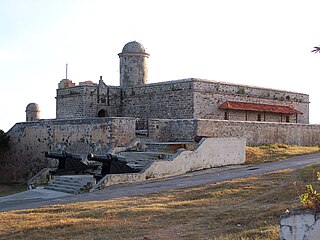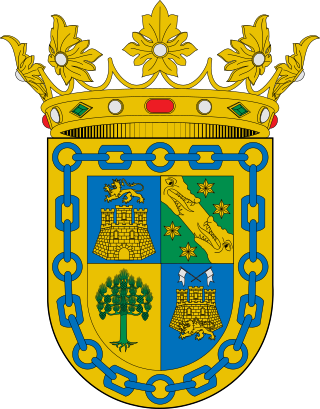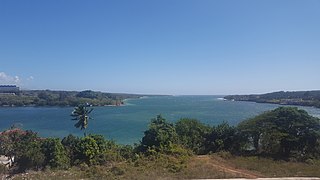
The Bay of Pigs is an inlet of the Gulf of Cazones located on the southern coast of Cuba. By 1910, it was included in Santa Clara Province, and then instead to Las Villas Province by 1961, but in 1976, it was reassigned to Matanzas Province, when the original six provinces of Cuba were re-organized into 14 new Provinces of Cuba.

Cienfuegos, capital of Cienfuegos Province, is a city on the southern coast of Cuba. It is located about 250 km (160 mi) from Havana and has a population of 150,000. Since the late 1960s, Cienfuegos has become one of Cuba's main industrial centers, especially in the energy and sugar sectors. The city is dubbed La Perla del Sur. Although Cienfuegos literally translates to "one hundred fires", the city takes its name from the surname of José Cienfuegos, Captain General of Cuba (1816–19).

The Sierra Maestra is a mountain range that runs westward across the south of the old Oriente Province in southeast Cuba, rising abruptly from the coast. The range falls mainly within the Santiago de Cuba and in Granma Provinces. Some view it as a series of connecting ranges, which join with others to the west. At 1,974 m (6,476 ft), Pico Turquino is the range's – and the country's – highest point. The area is rich in minerals, especially copper, manganese, chromium, and iron.
At the time of first contact between Europe and the Americas, the indigenous peoples of the Caribbean included the Taíno of the northern Lesser Antilles, most of the Greater Antilles and the Bahamas, the Kalinago of the Lesser Antilles, the Ciguayo and Macorix of parts of Hispaniola, and the Guanahatabey of western Cuba. The Kalinago have maintained an identity as an indigenous people, with a reserved territory in Dominica.

The Jagua Fortress is a fortress south of Cienfuegos in Cuba. It is located near the entrance to the Cienfuegos Bay, in the port of Jagua. It was originally named "Castillo de Nuestra Señora de los Ángeles de Jagua".

Cuban nobility encompasses all the individuals and families recognized in Cuba as members of the aristocratic class, hence possessing inheritance privileges.
Eliseo Valdés Erustes is a Cuban artist specializing in sculpture, painting, and drawing.
The following is a timeline of the history of Havana, Cuba.
The following is a timeline of the history of the municipality of San Juan, Puerto Rico.
The following is a timeline of the history of the city of Ponce, Puerto Rico.
Magali Alabau is a Cuban-American poet, theater director, and actor. Born in Cienfuegos, Cuba, she has lived in New York since 1966. She co-founded the Spanish-English ensemble Teatro Dúo/Duo Theatre with Manuel Martín, Jr. and the lesbian theater Medusa's Revenge with Ana María Simo. She began writing poetry after retiring from theater, and published eight books between 1986 and 2015.
The following is a timeline of the history of the city of Santiago, Cuba.

Cienfuegos Bay is a bay in the Caribbean Sea located in Cienfuegos Province on the southern coast of Cuba. It has served as a harbor for boats for many years. It has two of the most important ports in the country, one of which is the city of Cienfuegos, the capital of the province.
The following is a timeline of the history of the city of Camagüey, Cuba.
The following is a timeline of the history of the city of Matanzas, Cuba.
The following is a timeline of the history of the city of Holguín, Cuba.
The following is a timeline of the history of the city of Guantánamo, Cuba.
The following is a timeline of the history of the municipality of Mayagüez, Puerto Rico.






